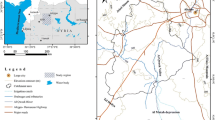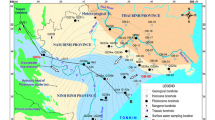Abstract
This study presents the data on the hydrochemical characteristics and isotope chemistry of Liwa aquifer, which could be useful to clarify the hydrochemical facies and hydrogeological regime in the study area. Electric conductivity and total dissolved solid values show that the investigated water is slightly brackish, due to the effect of evaporation and the occurrences of evaporite rocks in the adjacent Sabkhas of Abu Dhabi. Major cations and anions arranged according to their decreasing concentrations are: Na+ > Ca+2 > K+ > Mg+2 and Cl− > HCO3 − > SO −24 , respectively. As sodium is the dominate cation and chloride is the prevailing anion, hydrochemically the groundwater of Liwa can be classified as Na–Cl rich, predominantly chloridic. Ion concentrations increase towards the northeast and presumably coincide with the lithological sources of ions. Factors affecting the hydrochemistry of the groundwater of the investigated area include the effect of weathering of soil and rocks, evaporation and agricultural activities. Stable isotopes of oxygen and hydrogen show that the shallow aquifers contain a single water type that originated in a distinct climatic regime. This water type deviates from the local meteoric water line, as well as from the Eastern Mediterranean Meteoric Water Line, suggesting potential evaporation of recharged water prior to infiltration. The waters are poor in tritium, and thus can be considered generally as indication for recharge prior to 1952. The degradation of groundwater quality can be attributed to evaporation and agricultural practices in most cases.







Similar content being viewed by others
References
Alsharhan AS, Rizk ZA, Nairn AEM, Bakhit DW, Alhajari SA (2001) Hydrogeology of an arid region: the Arabian Gulf and adjoining areas. Elsevier, The Netherlands, p 331
Appelo CAJ, Postma D (1999) Geochemistry, groundwater and pollution. A. A. Balkema, The Netherlands, p 536
Awad MA, Hamza MS, Atwa SM, Sallouma MK (1996) Isotopic and hydrogeochemcial evaluation of groundwater at Qusier–Safaga area, eastern desert, Egypt. Environ Geochem Health 18:47–54
Banat KM, Howari FM, Al-Hamad AA (2005) Heavy metals in urban soils of central part of Jordan: Should we worry about their environmental risks. Environ Res 97(3):258–273
Barbieri M, Tiziano B, Marco P, Marco T (2005) Stable isotope (2H, 18O and 87Sr/86Sr)and hydrochemistry monitoring for groundwater hydrodynamics analysis in a karst aquifer (Gran Sasso, Central Italy). Appl Geochem 20:2063–2081
Clark I, Fritz P (1997) Environmental isotopes in hydrogeology. CRS Press LLC, USA
Cook PG, Herczeg AL (eds) (2000) Environmental tracers in subsurface hydrology. Kluwer, Boston, p 529
Davis SN, De Weist RJM (1966) Hydrogeology. Wiley, New York
Deutshce Gesellschaft fur Technische Zusammenarbeit (GTZ)-Dornier Consulting (DCo) (2000) Feasibility study on artificial recharge in the Liwa area. Environmental Reserch and Wildlife Development Agency, Abu Dhabi
Deutshce Gesellschaft fur Technische Zusammenarbeit (GTZ)-Dornier Consulting (DCo) (2002) GTZ-Groundwater assessment project of Abu Dhabi. Environmental Reserch and Wildlife Development Agency, Abu Dhabi
Drever JI (1982) The geochemistry of natural waters: surface and groundwater environments, 3rd edn. Prentice Hall, Upper Saddle River, NJ, 1, 410–411
Environmental Agency Abu Dhabi (EAD) (2006) Personnel communication
Epstein S, Mayeda T (1953) Variation of 18O content of waters from natural sources. Geochim Cosmochim Acta 4:213
Freez RA, Cherry JA (1979) Groundwater. Prentice Hall, Englewood Cliffs
Furtak H, Langguth HR (1967) Zur hydro-chemischen Kennzeichnung von Grundwässern und Grundwassertypen mittels Kennzahlen. IAH-Congress, 1965, Hannover: VII: 86–96
GTZ/DCO/ADNOC (2005) Status report phases 1Xa, IXb and Ixc for Groundwater Assessment Project Abu Dhabi. vol I-1: Exploration
Howari FM, Banat KM (2002) Hydrochemical characteristics of Jordan and Yarmouk river waters: effect of natural and human activities. J Hydrol Hydromech 50(1):50
IAEA/UNESCO (2001) Environmental isotope in the hydrological cycle-principles and applications. In: Mook WG (ed) IHP-V, Technical document no. 39, UNESCO, Paris
Izquierdo G, Alfred T, Julio A (2005) The geochemistry and isotope hydrology of the Southern Mexicali Valley in the area of the Cerro Prieto, Baja California (Mexico) geothermal field Enrique Portugal Enrique Portugal. J Hydrol 313:132–148
Kendall C, McDonnell JJ (1998) Isotopes tracers in catchments hydrology. Elsevier, Amsterdam
Murad A (2004) Chemical and isotopic investigation of groundwater in eastern United Arab Emirates (UAE). Western Michigan University, Faculty of the Graduate College, Department of Geosciences, PhD dissertation
North Dakota Department of Health (2005) http://www.health.state.nd.us/lab/REPORTS/REPORTS.HTM#Turbidity)
Piper A (1994) A graphical procedure in the geochemical interpretation of water analyses. Trans Am Geophys Union 25:237
Rizk ZS, Alsharhan AS (1999) Application of natural isotopes for hydrogeologic investigations in United Arab Emirates. In: Proceedings of the fourth Gulf Water conference, Manama, Bahrain, p 31
Rizk ZR, Alsharhan AS (2003) Hydrogeology, groundwater chemistry and isotope hydrology of the Quaternary Liwa aquifer in the western region of the UAE. The Sixth Gulf Water Conference (WASTA) in concurrence with the Second Symposium on Water Use and Rationalization in the Kingdom of Saudi Arabia, 8–12 March 2003
Sara MN, Gibbons R (1991) Organization and analysis of water quality data. In: Nielsen DM (ed) Practical handbook of ground water quality. Lewis Publishers, Inc., Chelsea, pp 541–588
Symonds R, Robledo A, Al Shateri H (2005) Use of environmental tracers to identify and date recent recharge to the surficial aquifer of northeastern Abu Dhabi Emirate, United Arab Emirates: NDC–USGS Technical Series Administrative Report 2005-001, p 24
Taha AA, El Mahmoudi AS, El-Haddad IM (2002) Evaluation of the water quality in new communities south east the Nile delta, Egypt. Emirates J Eng Res 8(2):51–67
Todd D (1980) Groundwater hydrology, 2nd edn. Wiley, New York
Turkian KK, Wedephole KH (1961) Distribution of the elements in some major units of the earth’s crust. Bull Geol Soc Am 72:175–178
United State Salinity Laboratory Staff (1954) Diagnosis and improvement of saline and alkaline soil. US Department of Agriculture, Handbook 60, Washington DC
World Health Organization (1990) International standards for drinking-water, 152 pp. Geneva, World Health Organization
Yair A, Karnieli A, Issar A (1991) The chemical composition of precipitation and runoff water on an arid limestone, Northern Negec, Israel. J Hydrol 129:371–388
Author information
Authors and Affiliations
Corresponding author
Rights and permissions
About this article
Cite this article
Al-Katheeri, E.S., Howari, F.M. & Murad, A.A. Hydrogeochemistry and pollution assessment of quaternary–tertiary aquifer in the Liwa area, United Arab Emirates. Environ Earth Sci 59, 581–592 (2009). https://doi.org/10.1007/s12665-009-0056-y
Received:
Accepted:
Published:
Issue Date:
DOI: https://doi.org/10.1007/s12665-009-0056-y




